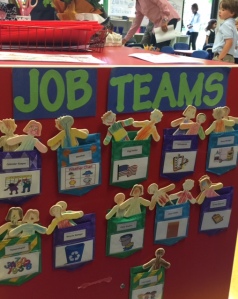 Grand Day is one of my favorite events at school for so many reasons, not the least of which is seeing the pride of students, teachers, and grands over the accomplishments of learning and friendships. Beyond that, listening to grandparents talk to each other about what they perceive as happening with and for their grandchildren allows me to see what we do with fresh eyes. I don’t know if it is the wisdom grandparents have earned over time or an appreciation for fundamentals now overlooked, but grandparents seem to recognize the implicit learning objectives built into our teaching as readily as they see the obvious, stated objectives. One grandparent stopped me to ask if we have always given the students “jobs” in the classroom. I thought, “Yes! We vertically align learning objectives and facilitate interdisciplinary experiences to deepen student understanding while empowering them with skills and strategies all of the time. Thank you for noticing.” I did not say that. After I explained the jobs chart, he was so impressed with the idea of developing academic skills while promoting a sense of personal responsibility and community. But, I wonder if we think about the depth of learning that will occur each year when those charts are set up. Or, have we done it so long that we just know “jobs” are what we do?
Grand Day is one of my favorite events at school for so many reasons, not the least of which is seeing the pride of students, teachers, and grands over the accomplishments of learning and friendships. Beyond that, listening to grandparents talk to each other about what they perceive as happening with and for their grandchildren allows me to see what we do with fresh eyes. I don’t know if it is the wisdom grandparents have earned over time or an appreciation for fundamentals now overlooked, but grandparents seem to recognize the implicit learning objectives built into our teaching as readily as they see the obvious, stated objectives. One grandparent stopped me to ask if we have always given the students “jobs” in the classroom. I thought, “Yes! We vertically align learning objectives and facilitate interdisciplinary experiences to deepen student understanding while empowering them with skills and strategies all of the time. Thank you for noticing.” I did not say that. After I explained the jobs chart, he was so impressed with the idea of developing academic skills while promoting a sense of personal responsibility and community. But, I wonder if we think about the depth of learning that will occur each year when those charts are set up. Or, have we done it so long that we just know “jobs” are what we do?
I have enjoyed the work we do as a professional learning community analyzing our curriculum and teaching practices to consider how we can get better. One of the things I have tried to do is bridge the perceived gap between early learning objectives and those of more advanced grade levels. On the surface, there may seem to be little connection between the tactile table and essay writing or color sorting and algebra, but foundational knowledge and skills are critical for future academic success. Is the connection difficult to see because we focus on the activity/lesson and not the why behind it? In his book, Start with Why, Simon Sinek says, “It is not just WHAT or HOW you do things that matters; what matters more is that WHAT and HOW you do things is consistent with your WHY. Only then will your practices indeed be best.” Are we starting with WHY when we plan our lessons? How might that look?
- Why: We believe students need a firm foundation of early literacy and math skills and habits that include conceptual understanding as well as procedural knowledge.
- What: We build number sense and phonological awareness while emphasizing strategies, communication, and flexible thinking.
- How: Daily lessons include number talks with subitizing activities and differentiated small groups during literacy block.
One might argue that it doesn’t make a difference where you begin if you end up in the same place. Only, I don’t think we always end up in the same place when we begin with the activity or lesson rather than with the WHY. So, I will continue to bridge the gap by pointing out the connections between early learning and upper grades, and highlighting how our WHY is the building of foundational skills/strategies for later success. I will always work to see what we do with fresh eyes.
(cross-posted on The Possibilities in Understanding)
Sinek, Simon. Start with Why: How Great Leaders Inspire Everyone to Take Action. New York: Portfolio, 2009. Print.
Learner, Thinker, Writer: Rhonda Mitchell serves the Trinity School community as the Early Elementary Division Head.
I love the structure and thinking in this post. Thank you for leading with why and including what and how. Your beautiful post helps me think about planning and messaging, and I love how you connect back to Simon Sinek’s TED talk.
The why is critically valuable. It gives purpose to the what and how.